英语人教版九年级全册节日来历补充
人教版PEP 初三九年级英语 上册第一学期秋季(文化背景资料)Unit 2 中国传统节日
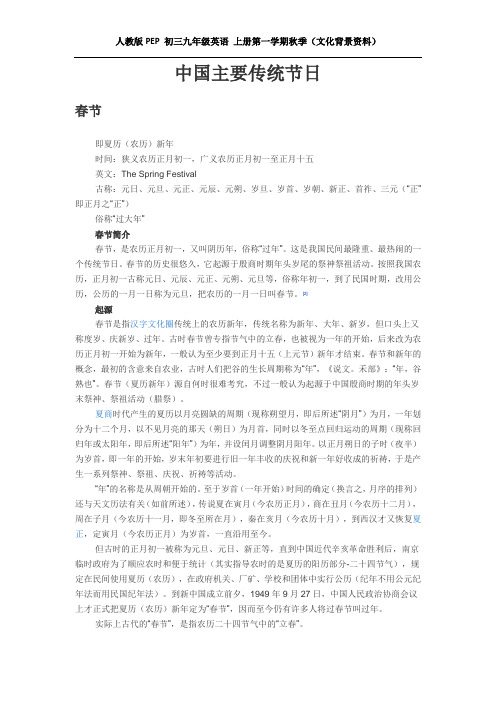
中国主要传统节日春节即夏历(农历)新年时间:狭义农历正月初一,广义农历正月初一至正月十五英文:The Spring Festival古称:元日、元旦、元正、元辰、元朔、岁旦、岁首、岁朝、新正、首祚、三元(“正”即正月之“正”)俗称“过大年”春节简介春节,是农历正月初一,又叫阴历年,俗称“过年”。
这是我国民间最隆重、最热闹的一个传统节日。
春节的历史很悠久,它起源于殷商时期年头岁尾的祭神祭祖活动。
按照我国农历,正月初一古称元日、元辰、元正、元朔、元旦等,俗称年初一,到了民国时期,改用公历,公历的一月一日称为元旦,把农历的一月一日叫春节。
[2]起源春节是指汉字文化圈传统上的农历新年,传统名称为新年、大年、新岁,但口头上又称度岁、庆新岁、过年。
古时春节曾专指节气中的立春,也被视为一年的开始,后来改为农历正月初一开始为新年,一般认为至少要到正月十五(上元节)新年才结束。
春节和新年的概念,最初的含意来自农业,古时人们把谷的生长周期称为“年”,《说文。
禾部》:“年,谷熟也”。
春节(夏历新年)源自何时很难考究,不过一般认为起源于中国殷商时期的年头岁末祭神、祭祖活动(腊祭)。
夏商时代产生的夏历以月亮圆缺的周期(现称朔望月,即后所述“阴月”)为月,一年划分为十二个月,以不见月亮的那天(朔日)为月首,同时以冬至点回归运动的周期(现称回归年或太阳年,即后所述“阳年”)为年,并设闰月调整阴月阳年。
以正月朔日的子时(夜半)为岁首,即一年的开始,岁末年初要进行旧一年丰收的庆祝和新一年好收成的祈祷,于是产生一系列祭神、祭祖、庆祝、祈祷等活动。
“年”的名称是从周朝开始的。
至于岁首(一年开始)时间的确定(换言之,月序的排列)还与天文历法有关(如前所述),传说夏在寅月(今农历正月),商在丑月(今农历十二月),周在子月(今农历十一月,即冬至所在月),秦在亥月(今农历十月),到西汉才又恢复夏正,定寅月(今农历正月)为岁首,一直沿用至今。
英语人教版九年级全册节日的英文表达

节日的英文表达元旦(1月1日) new year’s day成人节(日本,1月15日) adults day情人节(2月14日) st.valentine’s day (valentine’s day)元宵节(阴历1月15日) lantern festival狂欢节(巴西,二月中、下旬) carnival桃花节(日本女孩节,3月3日) peach flower festival (doll’s festival)国际妇女节(3月8日) international women’s day圣帕特里克节(爱尔兰,3月17日) st. patrick’s day枫糖节(加拿大,3-4月) maple sugar festival愚人节(4月1日) fool’s day复活节(春分月圆后第一个星期日) easter宋干节(泰国新年4月13日) songkran festival day食品节(新加坡,4月17日) food festival国际劳动节(5月1日) international labour day男孩节(日本,5月5日) boy’s day母亲节(5月的第二个星期日) mo ther’s day把斋节bamadan开斋节(4月或5月,回历十月一日) lesser bairam 银行休假日(英国, 5月31日) bank holiday国际儿童节(6月1日) international children’s day 父亲节(6月的第三个星期日) father’s day端午节(阴历5月5日) dragon boat festival仲夏节(北欧6月) mid-summer day古尔邦节(伊斯兰节,7月下旬) corban筷子节(日本,8月4日) chopstics day中秋节(阴历8月15日) moon festival教师节(中国,9月10日) teacher’s day敬老节(日本,9月15日) old people’s day啤酒节(德国十月节,10月10日) oktoberfest南瓜节(北美10月31日) pumpkin day鬼节(万圣节除夕,10月31日夜) halloween万圣节(11月1日) hallowmas感恩节(美国,11月最后一个星期4) thanksgiving护士节(12月12日) nruse day圣诞除夕(12月24日) christmas eve圣诞节(12月25日) christmas dad节礼日(12月26日) boxing day新年除夕(12月31日) new year’s eve(a bank holiday in many countries)春节(阴历一月一日) spring festival (chinese new year)。
Unit2中国节日英语简介2023-2024学年人教版九年级英语
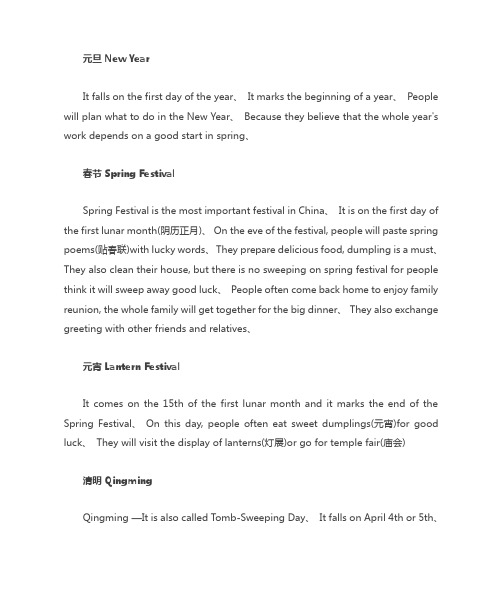
元旦New YearIt falls on the first day of the year、It marks the beginning of a year、People will plan what to do in the New Year、Because they believe that the whole year's work depends on a good start in spring、春节Spring FestivalSpring Festival is the most important festival in China、It is on the first day of the first lunar month(阴历正月)、On the eve of the festival, people will paste spring poems(贴春联)with lucky words、They prepare delicious food, dumpling is a must、They also clean their house, but there is no sweeping on spring festival for people think it will sweep away good luck、People often come back home to enjoy family reunion, the whole family will get together for the big dinner、They also exchange greeting with other friends and relatives、元宵Lantern FestivalIt comes on the 15th of the first lunar month and it marks the end of the Spring Festival、On this day, people often eat sweet dumplings(元宵)for good luck、They will visit the display of lanterns(灯展)or go for temple fair(庙会)清明QingmingQingming —It is also called Tomb-Sweeping Day、It falls on April 4th or 5th、That is a special day for the living to show love and respect to their dead friends or relatives、People often go to sweep the tomb and put the meat, wine in front of the tomb、One interesting thing is that people burn the paper money for the dead、端午Dragon Boat FestivalThis day is on the fifth of the fifth lunar month, People often get together to watch the w onderful “Dragon Boat Race”(龙舟大赛),Rice dumpling is a must on Dragon Boat Festival、中秋Mid-autumn DayIt comes on the 15th of the eighth lunar month、People often gaze at the “Lady in the moon”(嫦娥) and eat moon cakes、腊月二十三——小年December 23 of the Lunar Calendar (Little New Year) Custom: Worshiping the Kitchen GodAs the legend goes, there is a kitchen god in each house who is responsible for the kitchen and oversees the conduct of the family、On this day, the kitchen god returns to Heaven to report the conducts of the family to the Emperor of Heaven、Therefore, worshipping the kitchen god aims to “please him、” People put outsome sweet and sticky foods, such as rice dumplings and malted sugar、In this way, the lips of the kitchen god will stuck together, and he cannot report any wrong doings of the family、Thus the family can lead an auspicious life、习俗:祭灶民俗传说中,每家都有一位灶神掌管饮食,也记录一家人的言行。
九年级英语第二单元英语西方节日介绍 PPT

风靡全世界得节日。我们都知道这就是 一个属于情人们得节日,在这一天,您可以放心 大胆地向您得梦中情人表白自己对她(她)得 爱恋。但就是,这个节日得起源却不十分明确。 一直以来,二月就就是一个充满了浪漫气息得 月份,情人节也正就是一个包含了基督教与罗 马传统得节日。对于St、 Valentine本人,也有 许多传说。其中得一个说法便就是St、 Valentine公然反抗皇帝得命令,允许所有得年 轻人与自己心爱得姑娘结婚,而在当时,已经到 了服兵役年龄得年轻人就是不允许结婚得。
聪明滑稽得人在4月1日就给她们送假礼 品,邀请她们参加假招待会、并把上当
受骗得保守分子称为“四月傻瓜”或 “上钩得鱼”。 从此人们在4月1日便 互相愚弄,成为法国流行得风俗。18世 纪初,愚人节习俗传到英国,接着又被英 国得早期移民带到了美国。
Mother's Day
母亲节( Mother's Day)就是英美等国家为了表达 对母亲得敬意而设得一个节日。日期就是每年得 5月第二个星期日(the 2nd Sunday in May)。
母亲节起源于19世纪60年代得美国。据说当时在 美国 Philadelphia 有一个小地方,人们之间彼此关 系不十分友好,经常打架。当时有一位叫 Mrs、 Jarvis 得女士希望能改变这种状况,于就是她就开 始了一个所谓“母亲友谊节”(Mother's Friendship Day)。
每逢母亲节,做儿女得会送给自己得母 亲节日贺卡(Mother's Day Cards)、 鲜花(flowers)以及母亲们喜欢得精美 礼物(presents)等,同时,在这一天做父 亲得会领着子女们包揽家务,以便让做 母亲得有个休息得机会
Christmas is an important festival in Britain and many other parts of the world、 On Christmas Eve—the night before Christmas Day–children all over Britain put a stocking at the end of their beds before they go to sleep、 Their parents usually tell them that Father Christmas will e during the night、
英语人教版九年级全册中国传统节日及活动英译

中国传统节日及活动英译新年-New Year’s Day 春节-Spring Festival 三八节-International Working Women’s Day五一节-May Day五四节-Chinese Youth Day六一节-International Children’s Day八一建军节-Army Day中国共产党成立纪念日-Aniversary of the Founding of the Communist Party of China国庆节-National Day元宵节The Lantern Festival清明节The Tomb-sweeping Festival端午节The Dragon Boat Festival中秋节The Mid-Autumn Festival重阳节The Double Ninth Day七夕节The Double Seventh Day西方节日All Souls‘Da y 万灵节Easter Sunday,Easter 复活节Christmas 圣诞节Christmas Eve 圣诞前夕New Year‘s Eve 新年前夕前Holy Week 圣周All Saints‘ Day 万圣节成人节ADULTS DAY情人节ST.V ALENTINE‘S DAY狂欢节CARNIV AL桃花节PEACH FLOWER FESTIV AL-INTERNATIONAL WOMEN‘S DAY愚人节APRIL FOOL‘S DAY食品节FOOD FESTIV AL国际劳动节INTERNATIONAL LABOUR DAY男孩节BOY‘S DAY母亲节MOTHER‘S DAY开斋节LESSER BAIRAM银行休假日BANK HOLIDAY国际儿童节INTERNATIONAL CHILDREN‘S DAY 父亲节FATHER‘S DAY教师节TEACHER‘S DAY啤酒节OKTOBERFEST南瓜节PUMPKIN DAY鬼节HALLOWEEN万圣节HALLOWMAS感恩节THANKSGIVING护士节NRUSE DAY其它活动节日世界消费者权益日--WORLD CONSUMER RIGHT DAY 世界水日-----WORLD WATER DAY 世界卫生日-----WORLD HEALTH DAY 世界地球日-----WORLD EARTH DAY 世界住房日--WORLD HOUSING DAY国际秘书节----INTERNATIONAL SECRETARY DAY国际红十字日----INTERNATIONAL RED-CROSS DAY世界电信日----WORLD TELECOMMUNICATIONS DAY世界无烟日----WORLD NO-SMOKING DAY 世界环境日----WORLD ENVIRONMENT DAY世界人口日---WORLD POPULATION DAY世界旅游日----WORLD TOURISM DAY世界邮政日----WORLD POST DAY世界粮食日-----WORLD GRAIN DAY世界爱滋病日-----WORLD AIDS DAY世界残疾日------WORLD DISABLED DAY。
人教版英语九年级全册Unit7SectionA(3a3b)优秀教学案例

1.学生能够理解并尊重不同国家和文化的传统节日,培养跨文化交际的意识。
2.学生能够通过学习感恩节的来历和习俗,培养对家庭、朋友和生活的感恩之情。
3.学生能够在交流和讨论中,学会尊重他人,培养团队合作的意识。
4.学生能够通过学习英语,增强自信心,提高自主学习的能力,为未来的学习和生活打下坚实的基础。
四、教学内容与过程
(一)导入新课
1.课堂开始时,我会用多媒体展示一些与感恩节相关的图片,如火鸡、南瓜派、家庭成员团聚等,引起学生的兴趣和好奇心。
2.接着,我会提问学生:“你们对感恩节有什么了解?”鼓励学生分享自己的知识和经验,从而引出本节课的主题。
(二)讲授新知
1.在学生对感恩节有一定了解的基础上,我会开始讲授新知。我会用PPT展示感恩节的来历和传统习俗,并用简单的英语进行解释。
2.问题导向:通过设计一系列有针对性的问题,本案例引导学生进行深入思考和探究,培养了他们的批判性思维能力和问题解决能力。
3.小组合作:通过小组讨论和合作完成任务的活动,本案例有效地促进了学生之间的互动和合作,培养了他们的团队协作能力和沟通能力。
4.反思与评价:通过自我反思和同伴评价的过程,本案例帮助学生了解自己的学习成果和不足之处,提高了他们的自我认知和评价能力。
三、教学策略
(一)情景创设
1.为了激发学生的学习兴趣,我将以多媒体课件展示美国的感恩节场景,如超市里的节日装饰、家庭聚餐的照片等,让学生直观地感受到节日的氛围。
2.我将设计一个角色扮演的活动,让学生扮演不同角色,如厨师、家庭主妇、游客等,用英语讨论感恩节的习俗和计划,让学生在真实的情境中运用所学知识。
2.在讲授过程中,我会适时引入本节课的重点词汇和句型,如“celebrate,” “tradition,” “family reunion,” “give thanks,”等,并让学生跟读和模仿。
2019秋人教版九年级英语上册 中秋节英文介绍
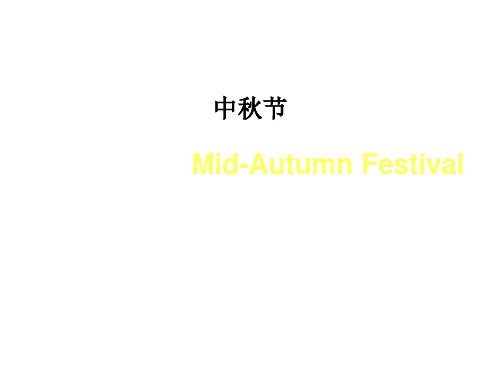
Chang’e flies to the moon.嫦娥奔月
Hou Yi shot 9 suns. Chang’e met Hou Yi and they got married. Hou Yi went to the Kunlun Mountains to look for an
中秋节
Mid-Autumn Festival
The Origin故事起源
• Mid-Autumn Festival is one of the four traditional Chinese festivals. The others are Spring Festival, Tomb-sweeping Day and Dragon Boat Festival.
harvest. • 中秋节是中国四大传统节日之一,其它三个节日是春节,
清明节和端午节。人们定期在中国农历八月十五日来庆祝 这个节日。旧社会时,在这一天,君王等统冶阶级祁求一 年好运,农民等低层社会人们也庆祝丰收。
Hou Yi shoots down nine suns.
后羿射日
Chang’e flies to the moon.
The Poems
• 春江潮水连海平,海上明月共潮生。
• In spring, the river rises as high as the sea. And with the river’s rise the moon uprises bright.
• 但愿人长久,千里共婵娟。
• May the people live forever, and share the moon shine across vast distances together.
中国节日介绍英文版

中国节日介绍英文版中国节日介绍英文版一、农历节日农历正月初一春节(the Spring Festival)农历正月十五元宵节(Lantern Festival)农历五月初五端午节(the Dragon-Boat Festival)农历七月初七乞巧节(中国情人节)(Double-Seventh Day) 农历八月十五中秋节(the Mid-Autumn Festival)农历九月初九重阳节(the Double Ninth Festival)农历腊月初八腊八节(the laba Rice Porridge Festival)二、阳历节日1月1日元旦(New Year's Day)2月2日世界湿地日(World Wetlands Day)2月14日情人节(Valentine's Day)3月3日全国爱耳日3月5日青年志愿者服务日3月8日国际妇女节(International Women' Day)3月9日保护母亲河日3月12日中国植树节(China Arbor Day)3月14日白色情人节(White Day)3月14日国际警察日(International Policemen' Day)3月15日世界消费者权益日(World Consumer Right Day)3月21日世界森林日(World Forest Day)3月21日世界睡眠日(World Sleep Day)3月22日世界水日(World Water Day)3月23日世界气象日(World Meteorological Day)3月24日世界防治结核病日(World Tuberculosis Day)4月1日愚人节(April Fools' Day)4月5日清明节(Tomb-sweeping Day)4月7日世界卫生日(World Health Day)4月22日世界地球日(World Earth Day)4月26日世界知识产权日(World Intellectual Property Day) 5月1日国际劳动节(International Labour Day)5月3日世界哮喘日(World Asthma Day)5月4日中国青年节(Chinese Youth Day)5月8日世界红十字日(World Red-Cross Day)5月12日国际护士节(International Nurse Day)5月15日国际家庭日(International Family Day)5月17日世界电信日(World Telecommunications Day)5月20日全国学生营养日5月23日国际牛奶日(International Milk Day)5月31日世界无烟日(World No-Smoking Day)6月1日国际儿童节(International Children's Day)6月5日世界环境日(International Environment Day)6月6日全国爱眼日6月17日世界防治荒漠化和干旱日(World Day to combat desertification)6月23日国际奥林匹克日(International Olympic Day)6月25日全国土地日6月26日国际禁毒日(International Day Against Drug Abuse and Illicit Trafficking)7月1日中国共产党诞生日(Anniversary of the Founding of the Chinese Communist Party)7月1日国际建筑日(International Architecture Day)7月7日中国人民抗日战争纪念日7月11日世界人口日(World Population Day)8月1日中国人民解放军建军节(Army Day)8月12日国际青年节(International Youth Day)9月8日国际扫盲日(International Anti-illiteracy Day)9月10日中国教师节(Teacher's Day)9月16日中国脑健康日9月16日国际臭氧层保护日(International Day for the Preservation of the Ozone Layer)9月20日全国爱牙日9月21日世界停火日(World Cease-fire Day)9月27日世界旅游日(World Tourism Day)10月1日中华人民共和国国庆节(National Day)10月1日国际音乐日(International Music Day)10月1日国际老年人日(International Day of Older Persons)。
Unit2中国节日英语简介202X-2024学年人教版九年级英语
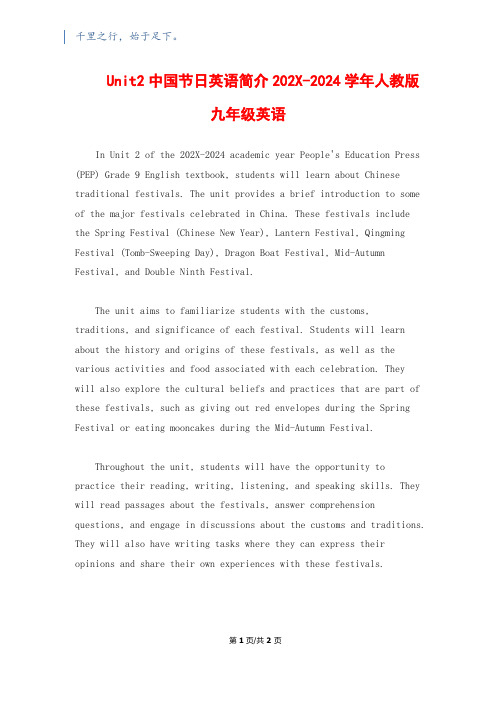
千里之行,始于足下。
Unit2中国节日英语简介202X-2024学年人教版九年级英语In Unit 2 of the 202X-2024 academic year People's Education Press (PEP) Grade 9 English textbook, students will learn about Chinese traditional festivals. The unit provides a brief introduction to some of the major festivals celebrated in China. These festivals include the Spring Festival (Chinese New Year), Lantern Festival, Qingming Festival (Tomb-Sweeping Day), Dragon Boat Festival, Mid-Autumn Festival, and Double Ninth Festival.The unit aims to familiarize students with the customs,traditions, and significance of each festival. Students will learn about the history and origins of these festivals, as well as the various activities and food associated with each celebration. Theywill also explore the cultural beliefs and practices that are part of these festivals, such as giving out red envelopes during the Spring Festival or eating mooncakes during the Mid-Autumn Festival.Throughout the unit, students will have the opportunity topractice their reading, writing, listening, and speaking skills. They will read passages about the festivals, answer comprehension questions, and engage in discussions about the customs and traditions. They will also have writing tasks where they can express their opinions and share their own experiences with these festivals.第1页/共2页锲而不舍,金石可镂。
人教版go for it九年级英语 Unit 2文化背景资料

1中泰两国的“泼水节”泰国泼水节即泰国新年,称作“宋干节”(The Songkran Festival),是泰国最重要的传统节日,代表着清除所有的斜恶、不幸的罪恶,并怀着一切美好和纯净开始新的一年,泼水节为每年4月13日到15日。
这三天里整个泰国都在庆祝,热闹非凡,尤以清迈最为壮观,很多泰国人都在那里过泼水节。
我国傣族也有泼水节,这里傣族的新年佳节,为公历四月中旬,一般持续三至七天。
第一天傣语叫“麦日”,与农历的除夕相似;第二天傣语叫“恼日”(空日);第三天是新年,叫“叭网玛”,意为岁首,人们把这一天视为最美好、最吉祥的日子。
这也是云南少数民族中影响面最大,参加人数最多的节日。
2我国的几个传统文化节目1)春节中华民族最悠久、最隆重的传统节日,民间人们把春节俗称作“年”,过春节叫“过年”。
这一节目的风俗主要有:扫尘、贴春联、挂年画、放爆竹燃烟花、守岁、拜年、包饺子、吃年糕等;节日活动主要有:舞狮子、耍龙灯、踩高跷、逛庙会等。
2)正月十五(元宵节)新年开始后的第一个月圆之日,古时人们称其作“上元节”,这天夜晚为“元夜”,即今天的“元宵节”。
吃夜宵、闹花灯是这一节日的主要风俗,元宵节吃元宵(汤圆)象征着家庭的团圆、和谐与幸福。
节日活动主要有:吃完宵、张灯、观灯、猜灯谜、耍龙灯等。
3)端午节每年农历五月初五为端午节。
汉语言“初”和“端”均有“开始”之意,故初五又作“端五”由于唐玄宗李隆基生于八月初五,为避“五”字讳,用“午”谐音借代,方为“端午”。
吃粽子、赛龙舟是这一节日的主要风俗和活动。
4)中秋节每年农历八月十五为中秋节。
农历七、八、九月为秋季,八月居中,故称“中秋”。
中秋习俗均与月亮有关,如吃月饼、赏月、祭月、拜月等。
圆圆的月亮、圆圆的月饼都象征了团团圆圆之意,因此,合家团聚是这一节日的头等要事。
这一天,身处异国他乡不能与亲人团圆的游子,思乡之情尤为强烈。
3西方英语国家的三个传统节日圣诞节(Christmas)、复活节(Easter)和万圣节前夕(Halloween)是西方英语国家三个十分重要的节日。
初中英语节日的知识点总结

初中英语节日的知识点总结一、节日的定义和重要性节日是文化传统和社会习俗的重要组成部分,它们通常与特定的日期、活动和意义相关联。
在初中英语教学中,节日的知识点不仅帮助学生了解不同文化背景,还能提高他们对英语语境下节日表达的理解能力。
二、常见节日及其英语表达1. 新年 (New Year's Day)- 日期:1月1日- 活动:庆祝新的一年开始,制定新年计划和决心- 表达:Happy New Year!2. 春节 (Chinese New Year / Spring Festival)- 日期:农历新年,日期变动- 活动:家庭团聚,放鞭炮,舞龙舞狮- 表达:Gong Xi Fa Cai (恭喜发财), wishing prosperity3. 清明节 (Qingming Festival)- 日期:公历4月4日或5日- 活动:扫墓,祭祖,踏青- 表达:Remembering ancestors with respect4. 劳动节 (Labor Day)- 日期:5月1日- 活动:表彰劳动者,休息和游行- 表达:Happy Labor Day!5. 儿童节 (Children's Day)- 日期:6月1日- 活动:儿童表演,游戏和礼物- 表达:Happy Children's Day to all kids!6. 万圣节前夜 (Halloween)- 日期:10月31日- 活动:装扮,不给糖就捣蛋,南瓜灯- 表达:Trick or treat!7. 圣诞节 (Christmas Day)- 日期:12月25日- 活动:家庭聚会,圣诞树,交换礼物- 表达:Merry Christmas!三、节日相关的英语词汇- 节日 (Festival/Holiday)- 传统 (Tradition)- 庆祝 (Celebrate)- 礼物 (Gift/Present)- 装饰 (Decoration)- 食物 (Food)- 活动 (Activity)- 习俗 (Custom)- 家庭聚会 (Family reunion)- 纪念 (Commemorate)四、节日的英语句型和表达1. 询问节日:- When is ...?- What do you do to celebrate ...?2. 描述节日活动:- We usually ... on ...- People often ... during ...3. 表达节日祝福:- I hope you have a wonderful time on ...- Wishing you a happy and peaceful ...4. 讨论节日意义:- ... is a festival to remember ...- The purpose of ... is to ...五、节日知识的文化差异不同的文化背景下,节日的庆祝方式和意义可能有所不同。
人教版英语九年级全一册专题06话题2节假日及中国传统文化(知识梳理+专题过关)2023九上册期中考点

答卷时应注意事项1、拿到试卷,要认真仔细的先填好自己的考生信息。
2、拿到试卷不要提笔就写,先大致的浏览一遍,有多少大题,每个大题里有几个小题,有什么题型,哪些容易,哪些难,做到心里有底;3、审题,每个题目都要多读几遍,不仅要读大题,还要读小题,不放过每一个字,遇到暂时弄不懂题意的题目,手指点读,多读几遍题目,就能理解题意了;容易混乱的地方也应该多读几遍,比如从小到大,从左到右这样的题;4、每个题目做完了以后,把自己的手从试卷上完全移开,好好的看看有没有被自己的手臂挡住而遗漏的题;试卷第1页和第2页上下衔接的地方一定要注意,仔细看看有没有遗漏的小题;5、中途遇到真的解决不了的难题,注意安排好时间,先把后面会做的做完,再来重新读题,结合平时课堂上所学的知识,解答难题;一定要镇定,不能因此慌了手脚,影响下面的答题;6、卷面要清洁,字迹要清工整,非常重要;7、做完的试卷要检查,这样可以发现刚才可能留下的错误或是可以检查是否有漏题,检查的时候,用手指点读题目,不要管自己的答案,重新分析题意,所有计算题重新计算,判断题重新判断,填空题重新填空,之后把检查的结果与先前做的结果进行对比分析。
亲爱的小朋友,你们好!经过两个月的学习,你们一定有不小的收获吧,用你的自信和智慧,认真答题,相信你一定会闯关成功。
相信你是最棒的!专题06 话题2-节假日及中国传统文化【知识梳理】本单元的话题围绕“Festival(节日)”为主题,在做相关的题型时,要清楚节日的时间、起源、相关风俗等。
命题者一般是围绕大家熟知的节日、假期或者庆祝活动等来设置试题,要求考生根据已给出的提示或建议进行阅读理解或描写。
话题主要涉及节日习俗、节假日活动、庆祝方式等。
此类题目写作通常采用要点提示的方式来考查。
课文回顾:1.I’m going to Chiang Mai in two weeks.两星期后,我要去清迈。
【句型剖析】in two weeks 两周后in + 一段时间表示“在……之后”用于一般将来时用How soon 提问【易混辨析】in与afterAnna will come here after three o'clock. 安娜三点以后将会来这儿。
英语九年级全人教新课标 Unit 2Section A 1(1)
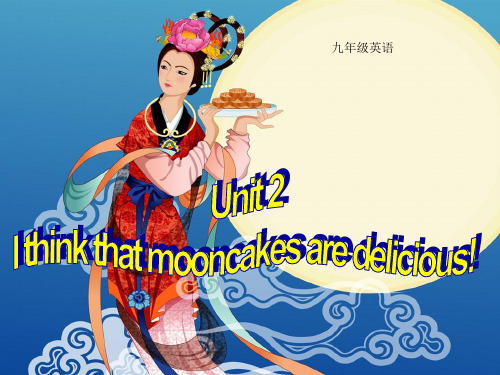
the Mid-Autumn Festival
中秋节
When is the Mid-Autumn Festival?
It falls on the 15th day of the 8th lunar month, usually in September. This day was also considered as a harvest(收获) festival .
The Dragon Boat Festival 端午节
When is the Dragon-Boat Festival?
The Dragon Boat Festival, also called the Duanwu Festival, is celebrated on the fifth day of the fifth lunar month .
The Water Festival 泼水节
When is the Water Festival?
It usually starts on the 13th of April a takes 3–7 days. The Water Festival is th New Year's celebrations that take place in Southeast Asian countries such as Burma (['bə:mə]缅甸) , Cambodia (['kæ mbəudiə]柬埔寨), Laos([laʊz]老挝) , and Thailand as well as Yunnan (Dai people) , China.
4. _c__ The Lantern Festival in Jiangxi
英语人教版九年级全册关于节日的内容

When is the Water Festival?
It usually starts on the 13th of April a takes 3–7 days. The Water Festival is th New Year's celebrations that take place in Southeast Asian countries such as Burma (['bə:mə]缅甸) , Cambodia (['kæ mbəudiə]柬埔寨), Laos([laʊz]老挝) , and Thailand as well as Yunnan (Dai people) , China.
How do Chinese people celebrate the Lantern Festival?
This day's important activity is watching lanterns. It is celebrated at night with lantern displays(展览) . At this time, people will try to solve the puzzles(迷) on the lanterns and eat yuanxiao and get all their families united.
Unit2SectionB万圣节英文介绍课件人教版英语九年级全册

到小气杰克死掉后,上帝不允许他 进入天堂,而魔鬼曾答应过他不会 让他下地狱,所以杰克死后哪都去 不了。因此,魔鬼就让他的灵魂漂 泊在黑夜里,只留给他一根燃烧的 蜡烛来指引他.从此以后,杰克就 把蜡烛放在挖空刻好的萝卜里,并 且一直留在人间吓人。爱尔兰人一 开始称之为杰克的南瓜灯笼( Jack of the Lantern),后来简称为杰克 南瓜灯( Jack-o-lantern)。
女巫因为会算命又会下好咒语和坏咒语,人们相信女巫们的能力在10月31日这天 会最强,所以让很多人很害怕她们。几世纪以来,女巫的形象改变许多,以前人们 认为,女巫都是绿皮肤,长的很老,脸上布满皱纹。现在则很多人认为女巫的能力 可以是邪恶或具有智慧的。
03
Ghosts are universal symbols for the departed. Skeletons and bones are symbols of death and shortness of life.
costuming, trick-or-treating, pinata, pumpkin carving.
等习俗,都可以追溯到凯特尔人Samhain节。
02
01 They trick or treat. 03 They carve pumpkin lanterns. 05 They visit haunted houses.
Spider(蜘蛛)
很多文化都视蜘蛛和蜘蛛网为编织生命 的象征,但在万圣节,他们却象征着黑 暗,恐怖的地方或长久被遗忘的鬼屋。
英语人教版九年级全册Mid-Autumn Festival

Things about Mid-Autumn Festival 中秋节有关的事物
Chang’e
family reunion (合家团聚)
2. What do mooncakes look like? What meanings do they carry?
The mooncakes are in the shape of a full moon on the Mid-Autumn night. They carry people’s wishes to the families they love and miss.
Hou Yi ② thanked; gave the goddess
① _sh_o_t_d_o_w__n
③⑥
Who can retell the story
called ouat;ccording to the mind
map?
laid out
通过思维导图复述故事
planned to
④ tried to steal Chang’e
the sky.有两种:时间状语和
___3__ H动ou词Y。i planned to drink the medicine with his
wife.
Discuss and finish the mind-map with key words.
Mind mapping: Change the information you read into a mind map. It helps you remember easily.
九年级英语全册文化背景资料Unit2Ithinkthatmooncakesaredelicious(节日中英文对照)(新版)人教新目标版
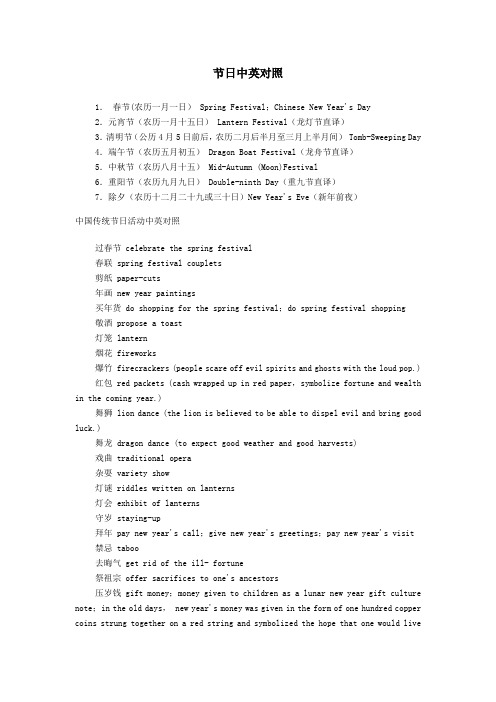
节日中英对照1.春节(农历一月一日) Spring Festival;Chinese New Year's Day2.元宵节(农历一月十五日) Lantern Festival(龙灯节直译)3.清明节(公历4月5日前后,农历二月后半月至三月上半月间) Tomb-Sweeping Day 4.端午节(农历五月初五) Dragon Boat Festival(龙舟节直译)5.中秋节(农历八月十五) Mid-Autumn (Moon)Festival6.重阳节(农历九月九日) Double-ninth Day(重九节直译)7.除夕(农历十二月二十九或三十日)New Year's Eve(新年前夜)中国传统节日活动中英对照过春节 celebrate the spring festival春联 spring festival couplets剪纸 paper-cuts年画 new year paintings买年货 do shopping for the spring festival;do spring festival shopping敬酒 propose a toast灯笼 lantern烟花 fireworks爆竹 firecrackers (people scare off evil spirits and ghosts with the loud pop.) 红包 red packets (cash wrapped up in red paper,symbolize fortune and wealth in the coming year.)舞狮 lion dance (the lion is believed to be able to dispel evil and bring good luck.)舞龙 dragon dance (to expect good weather and good harvests)戏曲 traditional opera杂耍 variety show灯谜 riddles written on lanterns灯会 exhibit of lanterns守岁 staying-up拜年 pay new year's call;give new year's greetings;pay new year's visit 禁忌 taboo去晦气 get rid of the ill- fortune祭祖宗 offer sacrifices to one's ancestors压岁钱 gift money;money given to children as a lunar new year gift culture note;in the old days, new year's money was given in the form of one hundred copper coins strung together on a red string and symbolized the hope that one would liveto be a hundred years old. today,money is placed inside red envelopes in denominations considered auspicious and given to represent luck and wealth 辞旧岁 bid farewell to the old year扫房 spring cleaning; general house-cleaning年糕nian-gao; rise cake; new year cake团圆饭 family reunion dinner年夜饭 the dinner on new year's eve饺子jiao-zi/dumpling; Chinese meat ravioli粽子rice dumpling。
人教版初中英语春节

人教版初中英语春节
人教版初中英语春节的介绍如下:
人教版初中英语教材中,有一篇关于春节的文章。
文章主要介绍了春节的起源、传统习俗以及现代庆祝方式。
通过学习这篇文章,学生可以了解春节的重要性,并掌握一些与春节相关的英语表达方式。
在文章中,学生可以学到以下内容:
1. 春节的起源:文章介绍了春节的起源,即农历新年的第一天。
春节是中国最重要的传统节日之一,已经有数千年的历史。
2. 传统习俗:文章列举了一些春节的传统习俗,如贴春联、放鞭炮、吃团圆饭、拜年等。
这些习俗是中国文化的重要组成部分,也是中国人庆祝春节的方式。
3. 现代庆祝方式:随着时代的发展,春节的庆祝方式也在不断变化。
文章介绍了现代人如何通过短信、电话、网络等方式拜年,以及如何通过旅游、看电影等方式庆祝春节。
通过学习这篇文章,学生可以了解到春节不仅仅是一个传统的节日,更是中国文化的重要组成部分。
同时,学生还可以掌握一些与春节相关的英语表达
方式,如“Happy Chinese New Year”、“Spring Festival”、“set off fireworks”等。
这些表达方式可以在日常交流中使用,帮助学生更好地与外国友人交流。
- 1、下载文档前请自行甄别文档内容的完整性,平台不提供额外的编辑、内容补充、找答案等附加服务。
- 2、"仅部分预览"的文档,不可在线预览部分如存在完整性等问题,可反馈申请退款(可完整预览的文档不适用该条件!)。
- 3、如文档侵犯您的权益,请联系客服反馈,我们会尽快为您处理(人工客服工作时间:9:00-18:30)。
有关节日一.西方节日一览表:Western festivals: Advent (耶稣)降临节Lady Day, Annunciation 天使报喜节(3月25日)Ascension Day 耶稣升天节(复活节后第四十日)Assumption 圣母升天节(8月15日)Candlemas 圣烛节(2月2日)New Year, New Year's Day 新年(1月1日)Corpus Christi 圣体节Quadragesima 四旬节(四旬斋的第一个星期日)Lent 四旬斋,大斋期(复活节前的第四十个星期日)Low (或Quasimodo) Sunday, 复活节后第一个星期日All Souls' Day (天主教)万灵节(11月2日)(如遇星期日则顺延一天) Palm Sunday 棕枝全日(复活节前的星期日)Easter Sunday, Easter 复活节Epiphany, Twelfth Day 主显节(1月6日)day of obligation 每人需停止工作参加礼拜的日子Maundy Thursday 濯足星期四(耶稣受难节)Shrove Tuesday 忏悔节(四旬斋开始的前一天)Ash Wednesday 复活节前的第七个星期三Christmas 圣诞节(12月25日)Christmas Eve 圣诞前夕New Year's Eve 新年前夕Easter 复活节Whitsun, Whitsuntide 圣神降临周(复活节后的第七周,尤指前三天) Quinquagesima 四旬斋前的星期日Ramadan 斋?/P>Rogation Days 祈祷节(耶稣升天节的前三天)Sabbath 安息日Feast of the Sacred Heart 圣心节Midsummer Day 施洗约翰节(6月24日)Passion Week 复活节前第二周Holy Week 圣周(复活节前一周)Septuagesima 四旬斋前的第三个星期日Sexagesima 四旬斋前的第二个星期日Ember Days 四季节All Saints' Day 万圣节Trinity Sunday, Trinity 圣三主日(复活节后的第八个星期日) Good Friday 耶稣受难节Visitation 圣母往见节(7月2日)1.Mother’s Day: A Celebration In Honor of All MothersMother's Day is a time of commemoration and celebration for Mom. It is a time of breakfast in bed, family gatherings, and crayon scribbled "I Love You"s.The history of Mother's DayThe earliest Mother's Day celebrations are traced back to the spring celebrations of ancient Greece in honor of Rhea, the Mother of the Gods.During the 1600's, England celebrated a day called "Mothering Sunday", celebrated on the 4th Sunday of Lent . "Mothering Sunday" honored the mothers of England. During this time many of the England's poor worked as servants for the wealthy. As most jobs were located far from their homes, the servants would live at the houses of their employers. On Mothering Sunday the servants would have the day off and were encouraged to return home and spend the day with their mothers. A special cake, called the mothering cake, was often brought along to provide a festive touch.As Christianity spread throughout Europe the celebration changed to honor the "Mother Church" -- the spiritual power that gave them life and protected them from harm. Over time the church festival blended with the Mothering Sunday celebration . People began honoring their mothers as well as the church.In the United States Mother's Day was first suggested in 1872 by Julia Ward Howe as a day dedicated to peace.In 1907 Ana Jarvis, from Philadelphia, began a campaign to establish a national Mother's Day. Ms. Jarvis persuaded her mother's church in Grafton, West Virginia to celebrate Mother's Day on the second anniversary of her mother's death, the 2nd Sunday of May. By the next year Mother's Day was also celebrated in Philadelphia. Ms. Jarvis and her supporters began to write to ministers, businessman, and politicians in their quest to establish a national Mother's Day. It was successful, by 1911 Mother's Day was celebrated in almost every state. President Woodrow Wilson, in 1914, made the official announcement proclaiming Mother's Day a national holiday that was to be held each year on the 2nd Sunday of May.While many countries of the world celebrate their own Mother's Day at different times throughout the year, there are some countries such as Denmark, Finland, Italy, Turkey, Australia, and Belgium which also celebrate Mother's Day on the second Sunday of May.Richer Than Gold-- Strickland Gillilan (1869-1954)I had a mother who read me thingsThat wholesome life to the boy heart brings --Stories that stir with an upward touch,Oh, that each mother of boys were such!You may have tangible wealth untold;Caskets of jewels and coffers of gold.Richer than I you can never be --I had a mother who read to me.2. Holloween西方节日万圣节前夜Halloween is a holiday observed 1 on the evening of October 31 inmost areas of North America and in some areas of Western Europe. Theword “Halloween” comes from “All Hallows' Eve.” November 1, “AllHallows' Day” (or “All Saints' Day”), is a Catholic (天主教的)festivalobserved in honour 2 of all saints. All Souls' Day, observed on November 2 to help purify 3 the spirits of the dead, is also closely linked to Halloween.北美的大部分和西欧部分地区在10 月31 日晚间庆祝万圣节前夜。
英文“ Halloween ”一词源于“ All Hallows' Eve ”。
11 月1 日是万圣节,天主教纪念所有圣徒的节日。
11 月 2 日是万灵节,帮助所有死者净化灵魂的节日,与万圣节前夜的关系也较密切。
Most Halloween customs are based on folk beliefs concerningsupernatural (超自然的)forces and spirits of the dead. Halloweendecorations (装饰)are typically images of supernatural beings suchas witches, werewolves (狼人), vampires, goblins (小妖怪), andghosts. Images thought to symbolize bad omens 4 — such as blackcats, bats, owls and spiders — are also commonly used as Halloween decorations. People once believed that ghosts roamed 5 the earth on Halloween. They also thought that allwitches met on October 31 to worship 6 the Devil. Today, most people do not believe in ghosts or witches, but these supernatural beings remain symbols of Halloween.万圣节前夜的大部分习俗与民间对妖魔和鬼魂的迷信有关。
